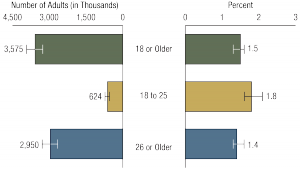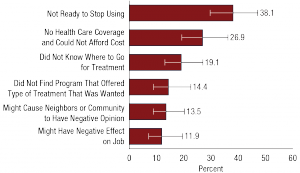ARTICLE SUMMARY: A 10-week intensive outpatient treatment program runs an average cost around $7,000, or from $100-150 per day. Costs vary based on services and total time spent in treatment. More on what to expect and how to fund a stay in an IOP here.
TABLE OF CONTENTS
- The Controversy
- What IOP is Like
- Who Needs Treatment
- Studies Comparing Prices
- Average Cost
- Range of Cost
- Low Cost Ideas
- Who is Best for IOP?
The Treatment Controversy
Some controversy surrounds the cost of addiction treatment in the U.S. While residential rehabs and detox clinics have been criticized for charging “an arm and a leg” for inpatient services, their outcomes are not statistically more successful than outpatient programs (especially intensive outpatient programs). In fact, research promoted by the National Institute on Drug Abuse that tracks individuals in treatment over extended periods has shown that most people who receive and remain in any formal treatment for addiction:
- Stop using drugs.
- Decrease criminal activity.
- Improve their occupational, social, and psychological functioning.
What’s the bottom line in the efficacy of inpatient vs. outpatient treatment? What does this type of addiction treatment cost? And what kind of client might benefit from an outpatient program? We review here, and invite your questions or comments about the cost of outpatient programs at the end.
What Intensive Outpatient Treatment Is Like?
Intensive Outpatient Treatment, or IOP, is a type of addiction treatment program that requires a major time commitment. Meetings are held at least 3 days a week for 2-4 hours a day or more. The duration of the program is 8-12 weeks, depending on a person’s needs. The major focus is relapse prevention. These outpatient programs are often scheduled around work or school.
Basically, an IOP program is much like a structured adult education support group, combined with individual therapy. You attend the clinic many times per week and check in with your counselor frequently in person and on the phone.
IOPs are there to help you adjust your behaviors and to work on psychological and emotional issues that drive you to drugs. Once you are able to resolve these deeper problems, your need to turn to drugs evolves. Instead, you are free to choose new, healthier behaviors. That’s the entire goal of treatment.
So, what types of therapies to IOPs generally use? The core of treatment for many intensive outpatient programs include six (6) common approaches that have been found to be effective over time. These therapies are said to be “Evidence-based” in that there is research to back up their effectiveness. They include:
- 12-Step Facilitation
- Cognitive Behavioral Therapy
- Community Reinforcement and Contingency Management
- Matrix Model
- Motivational Interviewing
- Therapeutic Community
About 1 in 12 people aged 18+ needed treatment for addiction in the U.S. in 2016.
Who Needs Treatment?
According to the National Survey on Drug Use in Health, in 2016, an estimated 19.9 million people adults aged 18 or older needed addiction treatment. This is about 8.1 percent of the U.S. adult population! So, how many are getting access to help?
About one in five people who need treatment received treatment for addiction in the past year.
In fact, in 2016, about 3.6 million adults aged 18 or older received some type of substance use treatment in the past year. Even less received specialty treatment like care in an intensive outpatient clinic. In 2016, 2.1 million adults got specialized, professional help. These people were treated in a hospital (as an inpatient), a drug or alcohol rehabilitation facility (as an inpatient or outpatient), or a mental health center. Nonspecialty help includes treatment in emergency rooms, private doctors’ offices, prisons or jails, and self-help groups.
Stated another way, among the 3.6 million adults who received any substance use treatment in the past year:
- 13.7 percent received only specialty treatment.
- 29.3 percent received only nonspecialty treatment.
- 46.0 percent received both specialty and nonspecialty treatment.
2016 NSDUH Graph Showing How Many People Received Addiction Treatment in the Past Year
Studies Comparing Pricing
A survey conducted in the early 2010’s by Open Minds consulting reported the average costs of addiction treatment services from 44 private treatment providers. They found that for a 10-week intensive outpatient treatment, the average cost was around $7,000.
Another recent scientific study took a look at the outcomes and costs of alcohol and drug treatment in day hospital vs. traditional outpatient clinics. Among randomized subjects, the average overall treatment costs were $1,640 for daily hospitals and $895 for traditional outpatient programs, respectively. In the groups of subjects with a mid-level psychiatric severity, the cost per treatment episode was more: approximately $5,450.
Finally, this government sponsored survey included a total of 13,000 Americans substance abuse treatment programs, and found that:
- 4% provide free treatment for all clients
- 10% offer free treatment to selected clients
- 38% offer both, free treatment for some and treatment on a sliding cost scale
- 24% don’t offer free treatment, but provide treatment on a sliding scale
- 27% don’t have free treatment nor sliding scale treatment options
- But, 76% of all substance abuse treatment facilities have some form of payment assistance
Are you looking for a treatment fit for your needs, but lack health insurance or can’t afford to pay the full price of treatment? Go to the Find Treatment section at the top of our page, or visit SAMHSA’s Substance Abuse Treatment Facility Locator for more options.
Average Costs
To the best of our knowledge, we estimate outpatient treatment to cost, on average, about $135 per day. But to be honest, there is very little information currently published on outpatient treatment program costs. Still, IOPs are less expensive than inpatient treatment. But, you shouldn’t be afraid to spend your money on a high quality IOP treatment program.
Factors that Influence Outpatient Costs
The charge for 30 days of intensive outpatient treatment can range anywhere from $3,000 up to $10,000. The cost of intensive outpatient treatment varies greatly, since every facility has different payment options, as well as services it charges for.
The range of cost for inpatient programs varies because a few factors play into overall pricing/ Here is a list of the main factors that can influence the final cost:
- Geographical location of the clinic (major urban areas are more expensive than rural clinics).
- Group counseling vs. individual counseling sessions (group sessions are less expensive).
- Services provided.
- The presence of a co-occurring mental health disorder, which also requires treatment.
- The total time you spend in treatment.
- Types of programs included in the treatment plan.
Ideas for Lowering Cost
Even though it’s far less-expensive than inpatient rehab, the reality is that outpatient care can still be quite expensive. Depending on the length of the program, addiction treatment can cost thousands of dollars per treatment episode. Still, prices vary widely.
Tips to help you pay for treatment include:
1. Check your health insurance.
You can call the number on the back of your card to get information of your mental health and substance abuse insurance coverage. You can find out what would be the additional costs, including deductible and co-payment amounts.
2. Search for treatment programs that offer sliding fee scale or reduced payment options.
Restrict a search in the national SAMHSA treatment directory for discounted services in IOP listings. This database can also be accessed via the substance abuse agency in your state, or call SAMHSA’s helpline on (1-800-662-HELP) and ask about affordable treatment options in your area.
3. Enquire about scholarships and state funded treatment.
IOPS may receive federal grant money that can be used to fund your treatment. These “Vouchers” are supervised by the state’s Department of Health and Human Services. Here is a listing of All State Health and Human Services Offices. Call them until you get an answer.
NSDUH: Why People Do Not Receive Addiction Treatment
Who is Best for IOP?
Outpatient treatment IS NOT FOR EVERYONE. IOPs require high levels of motivation. Your commitment to change needs to be internalized. Additionally, an IOP program may not be right for you if you were a heavy, long-term drug users. In these cases, it helps to seek help first from a residential rehab first.
Basically, an IOP might be right for you if:
- You are in good general health.
- You have support at home.
- You need to continue working, attending school, or caring for children at home.
- You have a high motivation to adopt new, healthy behaviors.
- You have already attended an inpatient rehab.
Your Questions
If you have any questions regarding fees or services provided by IOPS, feel free to post them in the section below. We try to answer your questions personally and promptly. Also, if you have a personal experience with this kind of treatment, we appreciate your input.











Related Posts